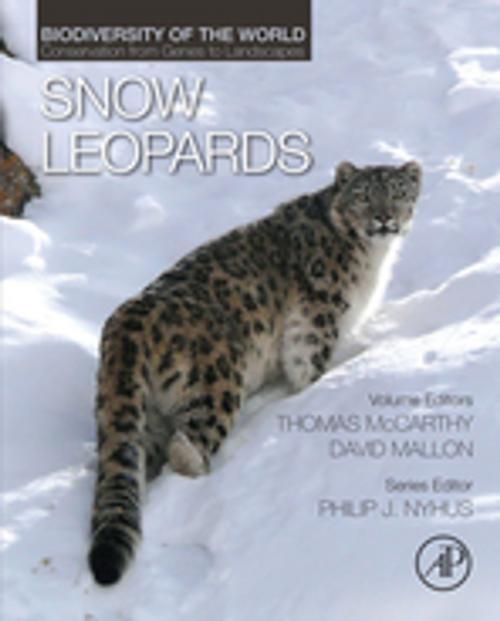Snow Leopards
Biodiversity of the World: Conservation from Genes to Landscapes
Nonfiction, Science & Nature, Nature, Animals, Animals Rights, Technology, Agriculture & Animal Husbandry| Author: | Philip J. Nyhus, Tom McCarthy, David Mallon | ISBN: | 9780128024966 |
| Publisher: | Elsevier Science | Publication: | June 6, 2016 |
| Imprint: | Academic Press | Language: | English |
| Author: | Philip J. Nyhus, Tom McCarthy, David Mallon |
| ISBN: | 9780128024966 |
| Publisher: | Elsevier Science |
| Publication: | June 6, 2016 |
| Imprint: | Academic Press |
| Language: | English |
Snow Leopards: Biodiversity of the World: Conservation from Genes to Landscapes is the only comprehensive work on the biology, behavior, and conservation status of the snow leopard, a species that has long been one of the least studied, and hence poorly understood, of the large cats.
Breakthroughs in technologies and methodologies to study this elusive cat have come rapidly, including non-invasive genetics, camera traps, and GPS-satellite collaring. The book begins with chapters on the genetic standing and taxonomy of the snow leopard, followed by chapters on their behavior and ecology. Additional contributions follow on the current and emerging threats to the species, which include longstanding concerns, such as poaching and conflicts with livestock, and new and emerging threats such as mining and climate change.
A section on conservation solutions, backed by valuable case studies, starts with an overview of the important role mountain communities play in assuring the snow leopard’s long-term persistence. In addition, chapters on the role of captive snow leopards for the conservation of the species, state-of-the-art techniques and technologies for studying and monitoring snow leopards, status reports from around the region, and future perspectives, such as transboundary conservation initiatives, international conventions (CITES, CMS, etc.), the role of the IUCN Cat Specialist Group and the Snow Leopard Network, and undertakings such as the Global Snow Leopard Forum facilitated by the World Bank are also included.
- Serves as the first and only comprehensive book on the biology, behavior, and conservation status of the snow leopard
- Brings together the most current scientific knowledge, documents the most pressing conservation issues, and shares success stories in alleviating the broad threats that now jeopardize the long-term survival of this species
- Brings current knowledge of the species, not only to researchers and conservationists, but also to decision makers, academics, and students
- Edited by recognized snow leopard experts, with more than 50 years of collective experience in research and conservation of the species
Snow Leopards: Biodiversity of the World: Conservation from Genes to Landscapes is the only comprehensive work on the biology, behavior, and conservation status of the snow leopard, a species that has long been one of the least studied, and hence poorly understood, of the large cats.
Breakthroughs in technologies and methodologies to study this elusive cat have come rapidly, including non-invasive genetics, camera traps, and GPS-satellite collaring. The book begins with chapters on the genetic standing and taxonomy of the snow leopard, followed by chapters on their behavior and ecology. Additional contributions follow on the current and emerging threats to the species, which include longstanding concerns, such as poaching and conflicts with livestock, and new and emerging threats such as mining and climate change.
A section on conservation solutions, backed by valuable case studies, starts with an overview of the important role mountain communities play in assuring the snow leopard’s long-term persistence. In addition, chapters on the role of captive snow leopards for the conservation of the species, state-of-the-art techniques and technologies for studying and monitoring snow leopards, status reports from around the region, and future perspectives, such as transboundary conservation initiatives, international conventions (CITES, CMS, etc.), the role of the IUCN Cat Specialist Group and the Snow Leopard Network, and undertakings such as the Global Snow Leopard Forum facilitated by the World Bank are also included.
- Serves as the first and only comprehensive book on the biology, behavior, and conservation status of the snow leopard
- Brings together the most current scientific knowledge, documents the most pressing conservation issues, and shares success stories in alleviating the broad threats that now jeopardize the long-term survival of this species
- Brings current knowledge of the species, not only to researchers and conservationists, but also to decision makers, academics, and students
- Edited by recognized snow leopard experts, with more than 50 years of collective experience in research and conservation of the species















